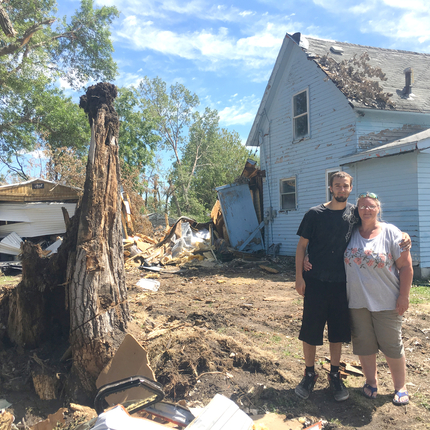By Cody Smith, former staff member
The derecho storm that hit central and eastern Iowa on Monday, Aug. 10, left a devastating swathe of damage that has residents still reeling. Many people have lost their homes, millions of acres of crops have been destroyed, and tens of thousands are still without power as Iowans work to recover from this storm. At the Center for Rural Affairs, we’ve been dealing with this crisis as well—our Iowa office was without power for a bit and as I’m working with our team to draft this, I’m also without power. As Iowans ourselves, we want you to know we’ve got your back.
As we all work to dig out of the widespread damage caused by last week’s storm, it is clear Iowans need access to swift and meaningful support to aid the recovery of our communities. In a time where our friends, families, and neighbors are in real need of help, we aim to make accessing state and federal programs for disaster recovery assistance as easy as possible for impacted Iowans.
The damage we saw last week was unprecedented. State estimates say $23.6 million of damage occurred to public infrastructure with an additional $21.6 million in cost associated with removal and disposal of debris from the storm. Meanwhile, the U.S. Department of Agriculture estimated 3.57 million acres of corn and 2.5 million acres of soybeans were impacted in 36 hardest hit counties for an estimated loss of $3.77 billion.
Given the magnitude of the storm damage and the complexity of available relief programs, the Center for Rural Affairs has worked to compile the following list of open assistance programs.
State programs for relief
In response to the devastating 100 mph+ sustained winds from the storm, Gov. Reynolds issued a state disaster proclamation in 27 counties throughout the rest of the week. Counties include: Audubon, Benton, Boone, Cass, Cedar, Clarke, Clinton, Dallas, Greene, Grundy, Guthrie, Hardin, Iowa, Jackson, Jasper, Johnson, Jones, Linn, Madison, Marshall, Muscatine, Polk, Poweshiek, Scott, Story, Tama, and Washington. These proclamations activated the Iowa Individual Assistance Grant Program and the Disaster Case Management Program.
The Iowa Individual Assistance Grant Program allows Iowans to apply for grants of up to $5,000 if their household income is up to 200 percent of the federal poverty level—a maximum annual income of $43,440 for a family of three. Iowans in the counties with state disaster proclamations can use these grants for home or car repairs, replacement of clothing or food, and temporary housing expenses, but they must present original receipts to receive reimbursement for expenses related to storm recovery. Applicants must apply within 45 days of the governor’s declaration in their county and can find application information on the Iowa Department of Human Services website.
The Disaster Case Management Program is also activated in the counties with state disaster proclamations to help address serious needs to overcome hardships, injury, or adverse conditions as a result of the derecho storm. There is no income threshold for Iowans seeking to access this program and they will be connected with disaster case managers to create a disaster recovery plan, receive guidance, and gain advice or referrals to obtain services or other needed resources. Iowans in eligible counties have 180 days from the date of the governor's proclamation to submit a claim, which can be done through their local community action association.
Federal programs for relief
On Sunday, Aug. 16, Gov. Reynolds formally requested an expedited presidential major disaster declaration totalling $3.99 billion. On Monday, Aug. 17, the President approved part of Gov. Reynolds’ request and issued a presidential major disaster declaration. This presidential disaster declaration opens up a Federal Emergency Management Agency (FEMA) program to assist Iowans with storm recovery. The President did not approve the parts of Gov. Reynolds’ request that asked for private assistance to individuals in affected counties, aid to utilities, or the requests for funds to help with crop losses.
Of the $3.99 billion total requested, the President has only approved $45 million to date. Among the components of the governor’s request that have not received approval are $3.77 billion for corn and soybean damage in Iowa’s 36 hardest hit counties and emergency funds for the 8,273 homes that were destroyed or significantly damaged, totaling $82.7 million in damage. Meanwhile, the presidential major disaster declaration also excluded a $100 million request for private utilities who are working to restore power to as many as 28,654 customers as of Aug. 19—more than a week after the storm.
Total funds requested by Gov. Reynolds

The $45.3 million that was approved will be made available as public assistance for local governments, state response efforts, tribal governments, and private nonprofits who are leading recovery efforts as a result of the storm. This includes approximately $21.6 million for debris removal, $14.46 million for utilities, and $7.53 million for building repairs.
The $45.3 million the federal government approved of Gov. Reynolds’ $3.99 billion request will be available for 16 counties under FEMA’s Public Assistance Program. This program helps repair and/or replace public infrastructure and assist with debris removal. To be eligible for funds, applicants for this program must be a state, territory, tribe, local government, or private nonprofit organization and pledge to remedy damages caused by the derecho storm. Eligible counties include: Benton, Boone, Cedar, Clinton, Dallas, Jasper, Johnson, Jones, Linn, Marshall, Muscatine, Polk, Poweshiek, Scott, Story, and Tama. Application materials can be found here.
As things change in the response to the storm, we will do our best to keep you updated.
Feature photo: Sherilyn Jensen and her son, Alex, in front of their home in McCallsburg, Iowa. They sustained significant property damage and have been staying in a hotel since the storm. | Photo by Kate Hansen.




